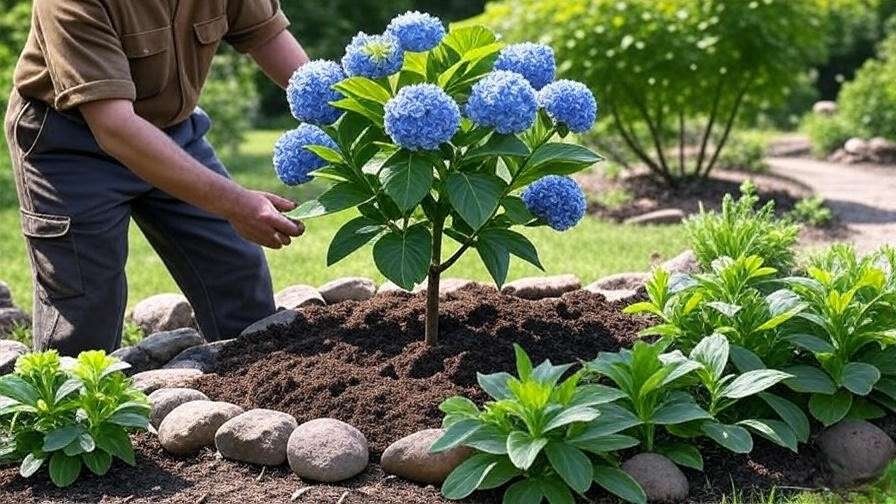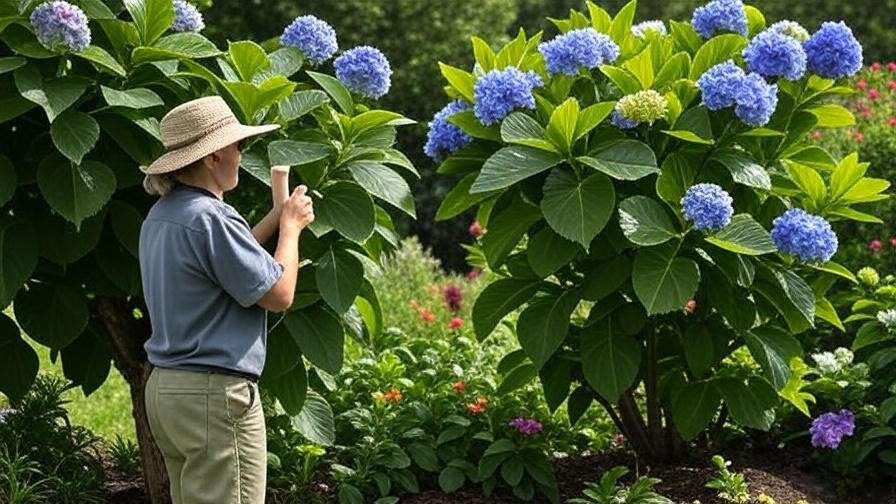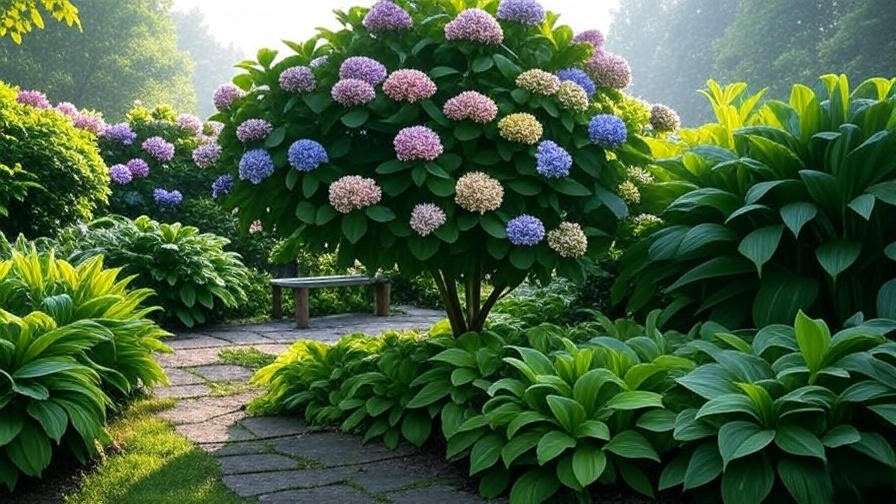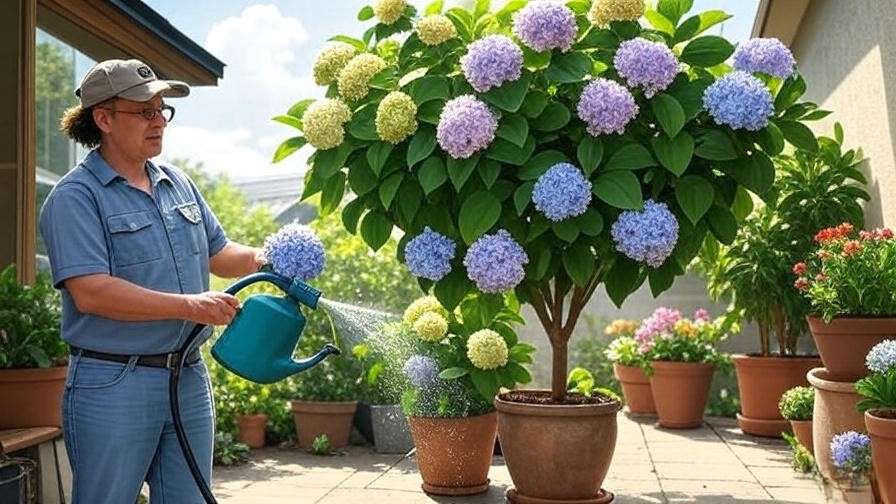Picture this: a breathtaking hydrangea tree in full bloom, its vibrant clusters of flowers stealing the show in your garden, turning heads and sparking joy! Whether you’re a seasoned gardener or just starting your plant care journey, growing a stunning hydrangea tree is within your reach. These elegant trees, known for their lush foliage and spectacular blooms, are a perfect way to elevate any outdoor space. In this comprehensive guide, we’ll walk you through everything you need to know about hydrangea tree care—from selecting the perfect variety to mastering planting, maintenance, and troubleshooting. With expert-backed tips and proven strategies, you’ll soon have a thriving hydrangea tree that blooms vibrantly year after year. Let’s dive into creating your garden masterpiece! 🌳
1. What Is a Hydrangea Tree? 🌳
1.1 Defining the Hydrangea Tree
A hydrangea tree is not your typical shrub—it’s a specially trained form of hydrangea, typically Hydrangea paniculata, pruned into a single-stemmed, tree-like shape. Unlike bushy hydrangea shrubs, these trees feature a sturdy trunk topped with a canopy of lush foliage and massive flower heads. Popular varieties like ‘Limelight,’ ‘Pinky Winky,’ and ‘Grandiflora’ are favored for their ability to be shaped into this elegant form. These trees typically grow 6–10 feet tall, making them ideal for small gardens, patios, or as focal points in larger landscapes.
What sets hydrangea trees apart is their versatility. They thrive in a range of climates (USDA zones 3–9) and offer blooms in shades of white, pink, or green, depending on the variety. Their long blooming season, often from mid-summer to fall, ensures months of visual appeal. For gardeners seeking a low-maintenance yet high-impact addition, the hydrangea tree is a top choice.
1.2 Benefits of Growing a Hydrangea Tree
Why choose a hydrangea tree for your garden? Here are a few compelling reasons:
- Aesthetic Appeal: Their structured form and vibrant blooms add elegance and drama to any landscape.
- Low Maintenance: Compared to other ornamental trees, hydrangeas require minimal upkeep once established.
- Extended Bloom Time: Enjoy flowers from summer through fall, with some varieties offering color changes as blooms mature.
- Versatility: Perfect for small spaces, containers, or as a centerpiece in mixed borders.
Expert Insight: According to Dr. Michael Dirr, a renowned horticulturist and author of Hydrangeas for American Gardens, “Hydrangea trees combine the charm of classic hydrangeas with the architectural elegance of a tree, making them a must-have for modern landscapes.”
2. Choosing the Right Hydrangea Tree for Your Garden 🌼
2.1 Selecting the Best Variety
Choosing the right hydrangea tree variety is crucial for success. Here’s a breakdown of top picks:
- ‘Limelight’: Known for its large, creamy-white blooms that transition to pink in fall. Thrives in full sun to partial shade.
- ‘Pinky Winky’: Features two-toned blooms (white at the base, pink at the tips) and a compact size, ideal for smaller gardens.
- ‘Grandiflora’ (PeeGee): A classic with cone-shaped white flowers, hardy in colder climates.
- ‘Quick Fire’: Early bloomer with flowers that turn deep pink-red, perfect for vibrant color.
When selecting, consider your climate, garden size, and aesthetic preferences. For colder regions (zones 3–4), opt for hardy varieties like ‘Limelight’ or ‘Grandiflora.’ In warmer climates (zones 7–9), ‘Pinky Winky’ or ‘Quick Fire’ perform well. Check your USDA hardiness zone to ensure compatibility.
2.2 Where to Buy a Healthy Hydrangea Tree
Purchase from reputable sources to ensure a healthy plant. Local nurseries, garden centers, or trusted online retailers like Proven Winners or Monrovia are excellent options. Look for:
- Healthy Roots: Firm, white roots without mushiness or rot.
- Strong Stems: A sturdy, single trunk with no signs of damage.
- Vibrant Foliage: Green, glossy leaves free from spots or yellowing.
Pro Tip: Avoid bargain plants from big-box stores, as they may be root-bound or stressed, leading to poor growth. Investing in a quality plant ensures long-term success.
3. Planting Your Hydrangea Tree: Step-by-Step Guide 🌱
3.1 Best Time to Plant
Timing is key for a thriving hydrangea tree. The ideal planting seasons are spring or early fall, when temperatures are mild, allowing roots to establish before extreme heat or cold. In colder climates, spring planting gives the tree time to settle before winter. In warmer regions, fall planting works well to avoid summer stress. Avoid planting during peak summer heat or freezing winter conditions.
3.2 Choosing the Perfect Location
Hydrangea trees thrive in locations with:
- Sunlight: 4–6 hours of direct sunlight daily, with afternoon shade in hot climates to prevent leaf scorch.
- Soil: Well-draining, slightly acidic soil (pH 5.5–6.5). Test your soil with a pH kit, available at garden centers.
- Space: Allow 6–8 feet of space for mature growth, ensuring good air circulation to prevent fungal issues.
If your soil is heavy clay or overly sandy, amend it with organic matter like compost or peat moss to improve drainage and fertility.
3.3 Planting Process
Follow these steps for successful planting:
- Dig the Hole: Make it twice as wide and as deep as the root ball.
- Amend the Soil: Mix native soil with compost (50:50 ratio) to boost nutrients.
- Position the Tree: Place the tree so the top of the root ball is level with the ground.
- Backfill and Water: Fill the hole, tamp down gently, and water deeply to settle the soil.
- Mulch: Add a 2–3 inch layer of organic mulch (e.g., bark or wood chips) around the base, keeping it away from the trunk to prevent rot.
Example: Jane, a gardener in Ohio, planted a ‘Limelight’ hydrangea tree in spring, choosing a spot with morning sun and afternoon shade. By following these steps, her tree bloomed profusely by its second summer, becoming the centerpiece of her garden.

4. Essential Care Tips for a Thriving Hydrangea Tree 🌞
4.1 Watering Requirements
Consistent moisture is critical, especially during the first two years. Water deeply once or twice a week, ensuring the soil stays moist but not waterlogged. In hot, dry weather, increase frequency, checking the top 2 inches of soil for dryness. For established trees, reduce watering to once weekly, adjusting for rainfall.
Pro Tip: Use a soaker hose or drip irrigation to deliver water directly to the roots, minimizing leaf wetness and fungal risks.
4.2 Fertilizing for Vibrant Blooms
Fertilize hydrangea trees to promote healthy growth and abundant blooms:
- Type: Use a balanced 10-10-10 fertilizer or a bloom-boosting formula (e.g., 15-30-15) in early spring.
- Timing: Apply once in early spring and again in mid-summer. Avoid late-season fertilizing to prevent tender growth before winter.
- Application: Spread granular fertilizer around the drip line (the area under the outer edge of the canopy), then water thoroughly.
Over-fertilizing can lead to lush foliage but fewer blooms, so follow package instructions carefully.
4.3 Pruning for Shape and Health
Pruning maintains the tree’s shape and encourages blooming:
- When: Late winter or early spring, before new growth begins.
- How: Remove dead or damaged branches, then trim back last year’s growth to 2–3 buds to promote larger blooms. Shape the canopy for a balanced look.
- Mistakes to Avoid: Pruning too late (after spring growth starts) can remove flower buds, reducing blooms.
Visual Aid: For a step-by-step pruning guide, check out the American Hydrangea Society’s pruning video [insert link to trusted source]. A well-pruned hydrangea tree will reward you with a fuller, healthier appearance.
4.4 Winter Care and Protection
In colder climates, protect your hydrangea tree from harsh winters:
- Mulch: Add a 4–6 inch layer of mulch around the base to insulate roots.
- Wrap: Use burlap or frost cloth to shield young trees from wind and frost.
- Water: Water deeply before the ground freezes to ensure hydration through winter.
Expert Insight: A study by the University of Minnesota Extension confirms that mulching significantly improves winter survival rates for Hydrangea paniculata in zones 3–4.
5. Troubleshooting Common Hydrangea Tree Problems 🐞
Even with the best care, hydrangea trees can face challenges. Here’s how to identify and address common issues to keep your tree thriving.
5.1 Why Aren’t My Hydrangea Trees Blooming?
Few things are more frustrating than a hydrangea tree that won’t bloom. Common causes include:
- Improper Pruning: Pruning at the wrong time (e.g., late spring) can remove flower buds. Stick to late winter or early spring pruning.
- Insufficient Sunlight: Less than 4 hours of sunlight daily can reduce blooming. Relocate or thin out nearby plants to increase light exposure.
- Nutrient Deficiencies: Lack of phosphorus can hinder flower production. Use a fertilizer with a higher middle number (e.g., 10-20-10) to boost blooms.
- Young Trees: Newly planted trees may take 1–2 years to establish before blooming profusely.
Solutions:
- Adjust pruning to late winter, cutting back to 2–3 buds per stem.
- Test soil pH and aim for 5.5–6.5, as extreme pH levels can affect nutrient uptake.
- Apply a bloom-boosting fertilizer in early spring.
Pro Tip: If blooms are sparse, test your soil with a kit from your local garden center to pinpoint nutrient issues. Patience is key—young trees often need time to mature.
5.2 Dealing with Pests and Diseases
Hydrangea trees are relatively pest- and disease-resistant, but issues can arise:
- Common Pests:
- Aphids: Small, sap-sucking insects that cause curled leaves. Control with a strong water spray or insecticidal soap.
- Spider Mites: Tiny pests causing stippled leaves. Use neem oil or increase humidity to deter them.
- Scale Insects: Hard, shell-like pests on stems. Remove manually or apply horticultural oil.
- Common Diseases:
- Powdery Mildew: White, powdery coating on leaves. Improve air circulation and apply organic fungicides like sulfur.
- Leaf Spot: Dark spots on leaves caused by fungi. Remove affected leaves and avoid overhead watering.
- Root Rot: Caused by overwatering or poor drainage. Ensure well-draining soil and reduce watering frequency.
Pro Tip: For eco-friendly pest control, mix 1 tablespoon of neem oil with 1 quart of water and a drop of dish soap. Spray affected areas every 7–10 days until pests are gone. Always monitor your tree for early signs of trouble to prevent escalation.

5.3 Addressing Environmental Stress
Environmental factors can stress your hydrangea tree, leading to symptoms like wilting, yellowing leaves, or stunted growth:
- Wilting: Often due to under- or overwatering. Check soil moisture and adjust watering to keep it consistently moist.
- Yellowing Leaves: May indicate nutrient deficiencies (e.g., nitrogen) or poor drainage. Test soil and amend with compost or fertilizer.
- Stunted Growth: Could result from compacted soil or insufficient sunlight. Loosen soil around the roots and ensure 4–6 hours of sun daily.
Solutions:
- Improve drainage by adding organic matter like compost to heavy soils.
- Relocate potted trees to a sunnier spot if possible.
- Use a soil moisture meter to maintain consistent watering.
6. Enhancing Your Hydrangea Tree’s Beauty: Design Tips 🌺
A hydrangea tree’s stunning blooms make it a natural focal point, but thoughtful design can elevate its impact in your garden.
6.1 Companion Planting
Pairing your hydrangea tree with complementary plants creates a cohesive, vibrant garden:
- Hostas: Their lush foliage contrasts beautifully with hydrangea blooms and thrives in similar partial-shade conditions.
- Ferns: Add texture and greenery, ideal for shaded areas beneath the tree.
- Low-Growing Perennials: Plants like lavender or catmint provide color at the base without competing for space.
Choose plants with similar water and light needs to simplify care. For example, planting astilbes alongside ‘Limelight’ hydrangeas creates a soft, romantic look with complementary pastel blooms.
6.2 Using Hydrangea Trees in Landscape Design
Hydrangea trees shine in various garden roles:
- Focal Point: Place a single tree in a lawn or near a patio to draw the eye.
- Border Planting: Line a walkway or fence with multiple trees for a dramatic effect.
- Container Gardening: Use dwarf varieties like ‘Pinky Winky’ in large pots for balconies or small spaces.
Example: In a Virginia garden, a homeowner used a ‘Quick Fire’ hydrangea tree as a centerpiece in a circular flower bed, surrounded by low-growing daylilies and ornamental grasses. The result was a stunning, low-maintenance display that bloomed from summer to fall.
Pro Tip: Add a bench or garden art near your hydrangea tree to create an inviting focal point for relaxation and enjoyment.

7. FAQs About Hydrangea Tree Care ❓
Q1: Can I Change the Bloom Color of My Hydrangea Tree?
Unlike Hydrangea macrophylla, which changes bloom color based on soil pH (blue in acidic soil, pink in alkaline), most hydrangea trees (Hydrangea paniculata) have fixed colors (white, pink, or green). However, some varieties like ‘Limelight’ shift from green to pink as blooms age. To influence subtle color changes:
- Test soil pH and adjust with sulfur (to lower pH) or lime (to raise pH).
- Note that color changes are limited compared to bigleaf hydrangeas.
Q2: How Long Does It Take for a Hydrangea Tree to Mature?
Hydrangea trees typically reach full size (6–8 feet tall and wide) in 3–5 years, depending on the variety and growing conditions. Blooms may appear in the first or second year but become more abundant as the tree matures. Regular care (watering, fertilizing, pruning) accelerates growth and bloom production.
Q3: Are Hydrangea Trees Deer-Resistant?
Hydrangea trees are moderately deer-resistant, but deer may nibble on young shoots or blooms in areas with high deer populations. Protect your tree by:
- Using deer-repellent sprays with natural ingredients like garlic or peppermint.
- Installing a physical barrier like netting around young trees.
- Planting deer-resistant companions like lavender or salvia nearby.
Q4: Can I Grow a Hydrangea Tree in a Pot?
Yes, compact varieties like ‘Pinky Winky’ or ‘Bobo’ thrive in containers. Use a large pot (at least 18–24 inches wide) with drainage holes, filled with well-draining potting mix. Water regularly and fertilize monthly during the growing season. Move potted trees to a sheltered spot in winter to protect roots from freezing.

8. Conclusion: Your Path to a Stunning Hydrangea Tree 🌟
Growing a stunning hydrangea tree is a rewarding journey that transforms your garden into a vibrant, blooming oasis. By choosing the right variety, planting in the ideal location, and following expert care tips—watering, fertilizing, pruning, and troubleshooting—you’ll enjoy a thriving tree with spectacular blooms year after year. Whether you’re enhancing a small patio or creating a grand landscape, hydrangea trees offer unmatched beauty and versatility.
Start your hydrangea tree journey today with confidence, knowing you have the tools to succeed. Share photos of your blooming masterpiece on social media or drop a question in the comments below—we’d love to hear about your garden! 🌸













